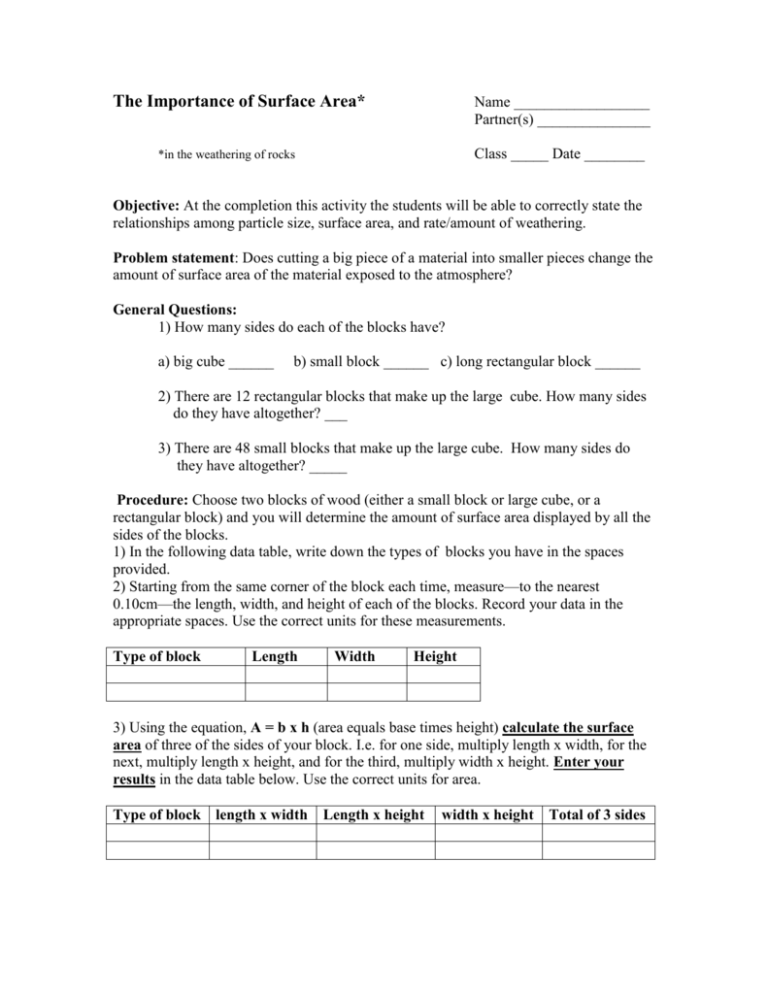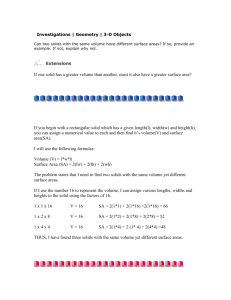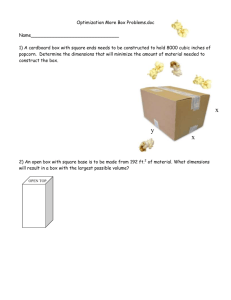The Importance of Surface Area
advertisement

The Importance of Surface Area* Name __________________ Partner(s) _______________ Class _____ Date ________ *in the weathering of rocks Objective: At the completion this activity the students will be able to correctly state the relationships among particle size, surface area, and rate/amount of weathering. Problem statement: Does cutting a big piece of a material into smaller pieces change the amount of surface area of the material exposed to the atmosphere? General Questions: 1) How many sides do each of the blocks have? a) big cube ______ b) small block ______ c) long rectangular block ______ 2) There are 12 rectangular blocks that make up the large cube. How many sides do they have altogether? ___ 3) There are 48 small blocks that make up the large cube. How many sides do they have altogether? _____ Procedure: Choose two blocks of wood (either a small block or large cube, or a rectangular block) and you will determine the amount of surface area displayed by all the sides of the blocks. 1) In the following data table, write down the types of blocks you have in the spaces provided. 2) Starting from the same corner of the block each time, measure—to the nearest 0.10cm—the length, width, and height of each of the blocks. Record your data in the appropriate spaces. Use the correct units for these measurements. Type of block Length Width Height 3) Using the equation, A = b x h (area equals base times height) calculate the surface area of three of the sides of your block. I.e. for one side, multiply length x width, for the next, multiply length x height, and for the third, multiply width x height. Enter your results in the data table below. Use the correct units for area. Type of block length x width Length x height width x height Total of 3 sides 4) You have now calculated half the surface area of the block. To get the total area of the block, you will need to double the total area you have already calculated. Do this now in the data table provided. Use the correct units for area. Type of Block Area of all 6 sides 5) We need to get the average total surface area for a small block, the rectangular blocks. We also need to record the total surface area of the large block. On the paper on the folding wall, record your results in the appropriate space. From these numbers we will need to calculate the averages for each type of block. Once this has been done, record the totals/averages in the blanks below. Use the correct units for area. Large Cube _____ Small Block _______ Rectangular Block _______ 6) The 12 rectangular blocks, the 48 small block, and the large cube are all the same volume. One of the purposes of this lab was to see if there would be any difference in the amount of surface area exposed when we cut the large block into the two sizes of smaller blocks. To do this we need to calculate the total surface area of: a) the 12 rectangular blocks—to do this multiply the average (from #5) times 12, b) the 48 small blocks—to do this multiply the average (from # 5) times 48, and record these results in the following blanks. Use the correct units for area. Large Cube _____ Small Cube ______ Rectangular Block ________ Analysis of Data: 1) How many times greater was the total surface of a) all 12 rectangular blocks than the large cube? ____________ b) all 48 small blocks than the large cube? ____________ 2) Name five ways rocks get weathered. Be specific. ------------------------------------------------------------------------------------------------------------ 7) As you know Alka-Seltzer fizzes when it is dropped in water and takes a certain amount of time to completely dissolve in the water. Write a formal hypothesis discussing particle size compared to dissolve time for Alka Seltzer. 8) Each group will have an entire Alka-Seltzer tablet. In some cases the tablet will be left whole, in others it will be broken into 2 “halves”, 4 “quarters” or many, little pieces. You will all drop ALL the Alka-Seltzer material into the same amount of water all at once and time how long it takes for the tablet to completely dissolve. (This is not the same as waiting for all the fizzing to stop. Look very carefully to see if there are any whole chunks of the tablet left. There will be an aspirin residue remaining in a powdered form.) In the table below list how many pieces your tablet was in, and list—to the nearest 0.10 seconds—how long it took for the piece(s) to completely dissolve. Number of pieces Time needed to completely dissolve Class Data: List in the appropriate space on the paper on the wall the amount of time it took your piece(s) of tablet to dissolve. After we calculate the averages, list the averages in the table below. Number of Pieces 1 2 3 4 many small pieces Time needed to completely dissolve Analysis of Data: 2) What is the relationship between the number of pieces and the amount of time needed for it/them to dissolve completely? 3) Draw a simple line graph of this relationship with time on the independent axis and number of pieces on the dependent axis. 4) What is the mathematical term for this type of relationship? ________________________________ Questions and Conclusions: 4) What is another factor which has an effect of the rate of dissolving of the AlkaSeltzer? How would it affect the rate of dissolving? ________________________________________________________________________ ________________________________________________________________________ ________________________________________________________________________ 5) Compare the weathering of a mountain of granite compared to the weathering of a pebble beach. Assume the mass of the material in question is the same. ________________________________________________________________________ ________________________________________________________________________ ________________________________________________________________________ 5) Weathering can be broken down into physical and chemical. Identify the two examples in this lab and classify them into physical and chemical weathering and why. ________________________________________________________________________ ________________________________________________________________________ ________________________________________________________________________ 6) How would you protect stone houses and other buildings from being weathered by physical and chemical agents ? ________________________________________________________________________ ________________________________________________________________________





